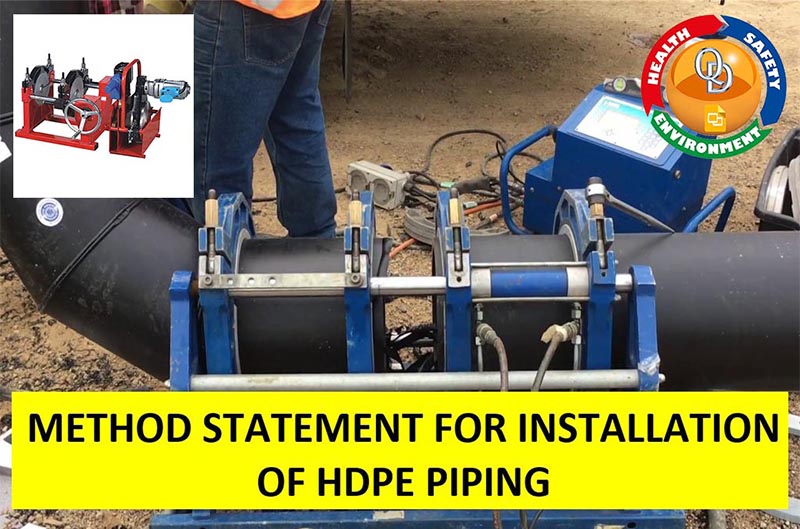Purpose:
This method statement uploaded by HSE Documents outlines the procedure for the installation of High-Density Polyethylene (HDPE) piping systems. The purpose is to ensure that the installation is carried out in a safe and efficient manner, adhering to industry standards and best practices.
Scope:
This method statement applies to the installation of HDPE pipes for various applications, such as water supply, sewerage, industrial piping, and other similar installations.
Responsibilities:
Project Manager: Overall responsibility for the successful execution of the installation process.
Site Engineer: Supervision of installation activities, ensuring compliance with the method statement and safety regulations.
Installation Team: Execution of the installation works, including cutting, welding, and jointing of HDPE pipes.
Materials and Equipment:
HDPE pipes, fittings, and accessories as per approved specifications.
Welding machine and accessories (e.g., heating plates, cutting tools, clamps, etc.).
Pipe supports and anchoring systems.
Testing equipment (e.g., pressure testing pump, pressure gauges).
Hand tools (e.g., wrenches, screwdrivers, measuring tape, etc.).
Personal protective equipment (PPE) for all personnel involved.
Installation Procedure:
5.1. Pre-Installation Activities:
Obtain necessary permits and approvals for the installation.
Ensure the availability of approved drawings, specifications, and relevant documents.
Conduct a site survey to identify and mark the locations for the pipeline installation.
Prepare the trench or excavation according to the approved drawings, ensuring proper alignment and slope.
Inspect the pipes, fittings, and accessories for any damage or defects before installation.
5.2. Pipe Cutting and Preparation:
Measure and mark the HDPE pipes according to the required lengths, taking into account expansion and contraction allowances.
Use a suitable cutting tool (e.g., power saw, pipe cutter) to cut the pipes cleanly and squarely.
Remove any burrs or sharp edges from the cut ends using a deburring tool or sandpaper.
5.3. Pipe Jointing:
Clean the pipe ends and fittings using a lint-free cloth and an appropriate cleaning solution.
Align the pipe ends and fittings properly, ensuring they are in the correct position and orientation.
Heat the welding machine to the recommended temperature for the specific HDPE pipe and fitting material.
Insert the heating plate into the fusion machine and allow it to reach the required temperature.
Apply a suitable welding compound to the heated plate.
Place the pipe ends squarely onto the heated plate, applying light pressure for the specified time.
Remove the pipe and fitting from the heating plate and join them together, following the manufacturer's instructions and welding standards.
Allow the joint to cool for the recommended time before moving or handling.
5.4. Pipe Support and Anchoring:
Install suitable pipe supports and anchors at regular intervals, as per the approved drawings and specifications.
Ensure that the pipe is adequately supported to prevent sagging or excessive movement.
Use non-metallic supports and cushioning materials to avoid damage to the pipe.
5.5. Hydrostatic Pressure Testing:
Perform hydrostatic pressure testing to ensure the integrity of the installed HDPE piping system.
Close all valves and fittings to isolate the section to be tested.
Gradually fill the section with water, ensuring that all air is vented.
Maintain the test pressure as per the specified requirements for the duration specified in the standards or project specifications.
Inspect the system for any leaks or abnormal pressure drops during the testing period.
If any leaks or defects are identified, repair or replace the affected components and retest.
Health, Safety, and Environmental Considerations:
All personnel involved in the installation must wear appropriate PPE, including safety helmets, safety shoes, gloves, and eye protection.
Follow all applicable safety regulations and guidelines to prevent accidents and injuries.
Properly handle and store HDPE pipes, fittings, and welding equipment to prevent damage.
Dispose of any waste material, such as scraps or cuttings, according to local environmental regulations.
Note: This method statement provides a general guideline for the installation of HDPE piping systems. It is essential to refer to specific project requirements, approved drawings, and industry standards during the execution of the installation.










0 Comments